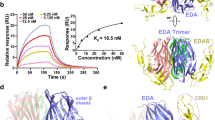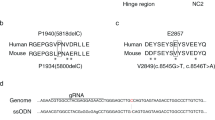Abstract
X-linked hypohidrotic ectodermal dysplasia results in abnormal morphogenesis of teeth, hair and eccrine sweat glands1. The gene (ED1) responsible for the disorder has been identified2,3,4, as well as the analogous X-linked gene (Ta) in the mouse5,6. Autosomal recessive disorders, phenotypically indistinguishable from the X-linked forms, exist in humans7 and at two separate loci (crinkled, cr, and downless, dl) in mice8. Dominant disorders, possibly allelic to the recessive loci, are seen in both species9,10 (ED3, Dlslk). A candidate gene has recently been identified at the dl locus11 that is mutated in both dl and Dlslk mutant alleles. We isolated and characterized its human DL homologue, and identified mutations in three families displaying recessive inheritance and two with dominant inheritance. The disorder does not map to the candidate gene locus in all autosomal recessive families, implying the existence of at least one additional human locus. The putative protein is predicted to have a single transmembrane domain, and shows similarity to two separate domains of the tumour necrosis factor receptor (TNFR) family12,13.
This is a preview of subscription content, access via your institution
Access options
Subscribe to this journal
Receive 12 print issues and online access
$209.00 per year
only $17.42 per issue
Buy this article
- Purchase on Springer Link
- Instant access to full article PDF
Prices may be subject to local taxes which are calculated during checkout




Similar content being viewed by others
References
Clarke, A. Hypohidrotic ectodermal dysplasia. J. Med. Genet. 24 , 659–663 (1987).
Kere, J. et al. X-linked anhidrotic (hypohidrotic) ectodermal dysplasia is caused by mutation in a novel transmembrane protein. Nature Genet. 13, 409–416 (1996).
Monreal, A.W., Zonana, J. & Ferguson, B. Identification of a new splice form of the EDA1 gene permits detection of nearly all X-linked hypohidrotic ectodermal dysplasia mutations. Am. J. Hum. Genet. 63, 380– 389 (1998).
Bayes, M. et al. The anhidrotic ectodermal dysplasia gene (EDA) undergoes alternative splicing and encodes ectodysplasin-A with deletion mutations in collagenous repeats. Hum. Mol. Genet. 7, 1661–1669 (1998).
Ferguson, B.M. et al. Cloning of Tabby, the murine homolog of the human EDA gene: evidence for a membrane-associated protein with a short collagenous domain. Hum. Mol. Genet. 6, 1589– 1594 (1997).
Srivastava, A.K. et al. The Tabby phenotype is caused by mutation in a mouse homologue of the EDA gene that reveals novel mouse and human exons and encodes a protein (ectodysplasin-A) with collagenous domains. Proc. Natl Acad. Sci. USA 94, 13069–13074 (1997).
Munoz, F. et al. Definitive evidence for an autosomal recessive form of hypohidrotic ectodermal dysplasia clinically indistinguishable from the more common X-linked disorder. Am. J. Hum. Genet. 61, 94– 100 (1997).
Sundberg, J.P. Handbook of Mouse Mutations with Skin and Hair Abnormalities (CRC Press, Boca Raton, 1994).
Majumder, K. et al. YAC rescue of downless locus mutations in mice. Mamm. Genome 9, 863–868 (1998).
Ho, L., Williams, M.S. & Spritz, R.A. A gene for autosomal dominant hypohidrotic ectodermal dysplasia (EDA3) maps to chromosome 2q11-q13. Am. J. Hum. Genet. 62, 1102–1106 (1998).
Headon, D.J. & Overbeek, P.A. Involvement of a novel TNF receptor homologue in hair follicle induction. Nature Genet. 22, 370–374 (1999).
Malek, N.P., Pluempe, J., Kubicka, S., Manns, M.P. & Trautwein, C. Molecular mechanisms of TNF receptor-mediated signaling. Recent Results Cancer Res. 147, 97– 106 (1998).
Naismith, J.H. & Sprang, S.R. Modularity in the TNF-receptor family. Trends Biochem. Sci. 23, 74–79 (1998).
Padanilam, B.J. et al. Characterization of the human HOX7 cDNA and identification of polymorphic markers. Hum. Mol. Genet. 1, 407–410 (1992).
Deloukas, P. et al. A physical map of 30,000 human genes. Science 282, 744–746 (1998).
Baala, L. et al. Both recessive and dominant forms of anhidrotic/hypohidrotic ectodermal dysplasia map to chromosome 2q11-q13. Am. J. Hum. Genet. 64, 651–653 (1999).
Konrad, M. et al. A 11 Mb YAC-based contig spanning the familial juvenile nephronophthisis region (NPH1) located on chromosome 2q. Genomics 30 , 514–520 (1995).
Jorgenson, R.J., Dowben, J.S. & Dowben, S.L. Autosomal dominant ectodermal dysplasia. J. Craniofac. Genet. Dev. Biol. 7, 403– 412 (1987).
Fisher, G.H. et al. Dominant interfering Fas gene mutations impair apoptosis in a human autoimmune lymphoproliferative syndrome. Cell 81, 935–946 (1995).
Tartaglia, L.A. & Goeddel, D.V. Tumor necrosis factor receptor signaling. A dominant negative mutation suppresses the activation of the 55-kDa tumor necrosis factor receptor. J. Biol. Chem. 267, 4304–4307 (1992).
Bettinardi, A. et al. Missense mutations in the Fas gene resulting in autoimmune lymphoproliferative syndrome: a molecular and immunological analysis. Blood 89, 902–909 (1997).
Infante, A.J. et al. The clinical spectrum in a large kindred with autoimmune lymphoproliferative syndrome caused by a Fas mutation that impairs lymphocyte apoptosis. J. Pediat. 133, 629–633 (1998).
Beldjord, C. et al. A novel β thalassemia gene with a single base mutation in the conserved polypyrimidine sequence at the 3´ end of IVS 2. Nucleic Acids Res. 16, 4927–4935 (1988).
Coolidge, C.J., Seely, R.J. & Patton, J.G. Functional analysis of the polypyrimidine tract in pre-mRNA splicing. Nucleic Acids Res. 25, 888–896 (1997).
Smith, C.A., Farrah, T. & Goodwin, R.G. The TNF receptor superfamily of cellular and viral proteins: activation, costimulation, and death. Cell 76, 959–962 (1994).
Frohman, M.A. Rapid amplification of complementary DNA ends for generation of full-length complementary DNAs: thermal RACE. Methods Enzymol. 218, 340–356 (1993).
Gyapay, G. et al. A radiation hybrid map of the human genome. Hum. Mol. Genet. 5, 339–346 (1996).
Kim, U.J. et al. Construction and characterization of a human bacterial artificial chromosome library. Genomics 34, 213– 218 (1996).
Arnold, C. & Hodgson, I.J. Vectorette PCR: a novel approach to genomic walking. PCR Methods Appl. 1, 39–42 (1991).
Zonana, J. et al. High-resolution mapping of the X-linked hypohidrotic ectodermal dysplasia (EDA) locus. Am. J. Hum. Genet. 51, 1036–1046 (1992).
Ferguson, B.M. et al. Scarcity of mutations detected in families with X linked hypohidrotic ectodermal dysplasia: diagnostic implications. J. Med. Genet. 35, 112–115 (1998).
Acknowledgements
We thank the families for participation; referring clinicians Z. Borochowitz, C. McKeown, C. DeLozier-Blanchet, R. Jorgensen and D. Bixler; J. Zeltinger and K. Holbrook for RNA from human fetal skin; J. Murray for the human embryonic craniofacial library; and J. Hejna and M. Litt for assistance in BAC screening and radiation hybrid mapping. This work was supported by NIH grants DE11311 (J.Z.) and AR45316 (P.A.O.), as well as by a grant from the National Foundation for Ectodermal Dysplasia (J.Z.).
Author information
Authors and Affiliations
Corresponding author
Rights and permissions
About this article
Cite this article
Monreal, A., Ferguson, B., Headon, D. et al. Mutations in the human homologue of mouse dl cause autosomal recessive and dominant hypohidrotic ectodermal dysplasia. Nat Genet 22, 366–369 (1999). https://doi.org/10.1038/11937
Received:
Accepted:
Issue Date:
DOI: https://doi.org/10.1038/11937
This article is cited by
-
EDA ligand triggers plasma membrane trafficking of its receptor EDAR via PKA activation and SNAP23-containing complexes
Cell & Bioscience (2023)
-
The Ectodysplasin receptor EDAR acts as a tumor suppressor in melanoma by conditionally inducing cell death
Cell Death & Differentiation (2019)
-
Conservation analysis and pathogenicity prediction of mutant genes of ectodysplasin a
BMC Medical Genetics (2018)
-
Attenuation of Mammary Gland Dysplasia and Feeding Difficulties in Tabby Mice by Fetal Therapy
Journal of Mammary Gland Biology and Neoplasia (2018)
-
Mutational spectrum in 101 patients with hypohidrotic ectodermal dysplasia and breakpoint mapping in independent cases of rare genomic rearrangements
Journal of Human Genetics (2016)



